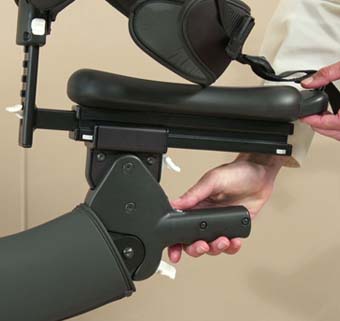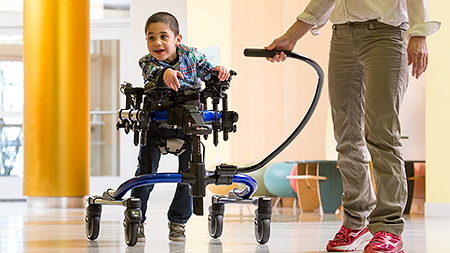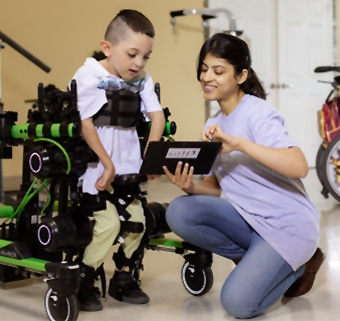Good Positioning for Optimal Gait Training
The Rifton Pacer allows for customized positioning for each individual to improve positioning for better success with gait. There are many ways the frame and accessories can be adjusted during the initial trial and fitting.
Watch more videos in this series:
Transcript of Video
The Rifton dynamic pacer allows for customized positioning for each individual to improve positioning for better success with gait. There are many ways the frame and accessories can be adjusted during the initial trial and fitting. Set aside time to determine the best settings to improve positioning for better success with gait.
Scott is 18 years old, with mild cerebral palsy and autism. He has generalized hypermobility and low tone and uses orthotics to stabilize his ankles.
In his first trial in the dynamic pacer Scott walked in extreme forward leaning posture with poor control. We set the brakes in order to adjust the accessories to improve his positioning. We removed the arm platforms and the posts so the clamp could be positioned farther back along the top frame. The dial under the arm platform was swiveled so that most of the surface would be as posterior as possible. The post is now placed to point inward. Each arm platform is positioned so it angles upward.
For the pelvic support we moved the clamp of the handhold farther forward. The handhold itself is placed to point inward so the pelvic support straps are closer to Scott’s hips. With the straps tightened the pelvic support will now provide better control.
We engaged the swivel lock on the rear casters and set the drag with increased resistance to help Scott gain better control of the frame while walking.
With these adjustments Scott walks in a more upright position and with far better control.
James is a 16-year-old with Rett Syndrome. He walks with close to 45 degrees of flexion at his hips and knees due to muscle contractures. His fixed upper thoracic kyphosis also contributes to a very crouched gait. Although x-rays show no subluxation, James complains of left hip pain which has been attributed to poor joint alignment.
James had been using the hip positioner and thigh prompts. We removed these in order to use the new multi position saddle. The MPS attaches to either upper frame on the dynamic Pacer. The MPS is ideal because it can be lowered independently to enable easier transfers. Further adjustments include seat angle for anterior or posterior tilt and forward or backward adjustment for positioning the pelvis relative to the trunk. Finally, the hip corral can be adjusted in depth and height to accommodate different body shapes.
Both the frame and MPS are lowered to obtain the right position for a simple forward slide to seat James on the MPS. With the hip corral secured the frame is raised and then the MPS adjusted as needed. In James’s case we add anterior tilt to help with leg alignment and foot positioning.
Further accessories such as the arm prompts are positioned and secured as needed. With the MPS, James no longer needs thigh prompts. He walks with significantly less crouch, taking steps more easily and without hip discomfort.
Reuben is 16 years old and has global developmental delay. He has had multiple surgeries for soft tissue releases and a left hip reconstruction after dislocation. Due to high tone he continues to have significant contractures at the hips, knees, and ankles, and internally rotated legs. Without a device he cannot walk. In the Dynamic Pacer Reuben uses the chest prompt since he tends to lean forward as he tires.
We observed that his feet were behind him, causing him difficulty with his gait. In addition the upper frame was too low, contributing to his crouched gait. The free-swiveling movement of the casters also made walking difficult.
By raising the upper frame, we could decrease the impact of his contractures on his gait. For Reuben, moving the MPS into a posterior tilt will help to bring his legs and feet forward for better alignment for walking.
We decided to use the swivel lock on the front casters, stabilizing the frame but allowing Reuben’s therapist to still guide the direction of movement from behind. We re-positioned Reuben’s arms in the forearm prompts and he was ready to go.
The results are fabulous. Reuben is achieving a typical walking pace. Here he’s making a beeline for the front door of the school building for his favorite activity: watching the school buses!






